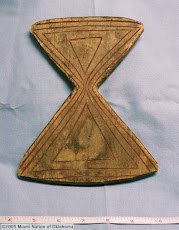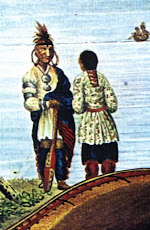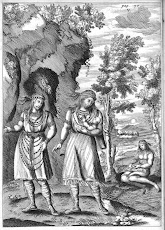Well, let me put those notions to the test. I have a huge collection of I-photos that include thousands of views of Woodland Indians and many showing different women wearing all of these items mentioned in the introduction. I am never quite sure where these crazy ideas come from as if somehow magically, a woman's skirt is supposed to stay up without the use of a belt or sash of some kind or that women had no need for the use of a knife. Certainly we do not see an extraordinary number of portraits or descriptions of women depicted wearing neck knife sheaths but my question is, if they didn't wear them around their neck and they didn't wear a sash, then where did they carry a knife?
I imagine that men feel as if most of history was written about them and about their feats in war and hunting, politics and as the "chiefs" of the tribe or village. Well, if you count the number of descriptions and portraits of Native women, that notion is also challenged significantly. Women have been discussed, painted, drawn and written about in journals, diaries and other historical works nearly as often as men. Women often are depicted carrying children, tending to domestic chores, and walking with their husbands. Even in pre-contact excavations, figurines of women are found just as often, if not more so than men. The importance of women in most Woodland cultures is often verified by these kinds of finds and by the number of women who make the decisions concerning warfare and politics in their group.
I want to include here several artistic renderings from selected time periods that dismiss, out of hand the notion that women did not wear sashes, etc. It is difficult to identify a "Native woodland Indian woman" based exclusively on what she is wearing. There is no such thing as a "Cherokee suit" or a "Shawnee dress." These ideas are unrealistic as cultures moved around a lot, despite not being truly "nomadic," and shared ideas with friends and enemies alike. The traders and outposts made some things more available in some areas and others were obscure or difficult to come by in other areas of the East and Great Lakes. Native people who were living or trading at large posts in the late 18th century had access to trade cloth, trade silver and kettles frequently but those that were located in remote areas of the lakes, mountains, and hills were sometimes isolated and were in contact less frequently with traders and white craftsmen.
The pictures depict some of the woodland women from the 17th century to the 19th century.






